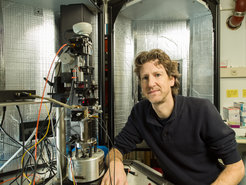Prof. Dr. Stefan Weber

Stefan studied Physics at the University of Konstanz where he received his Physics Diploma in 2007. In his PhD thesis at the Max Planck Institute for Polymer Reaearch (MPI-P), he used and developed electrical scanning force microscopy methods for the investigation of organic optoelectronic materials. The project was embedded in the international research training group (IRTG) "Self-organizing materials for optoelectronics" - a joint graduate school between University and MPI-P in Mainz and the Seoul National University (SNU) and Hannam University Daejon in South Korea. In 2009 and 2010 he spent 6 months at SNU in the groups of Prof. Kookheon Char and Prof. Changhee Lee. In 2010 he received a joint doctoral degree from Mainz University and SNU.
In 2011 he went to University College Dublin as a Feodor Lynen Fellow (Alexander von Humboldt Foundation). Together with Prof. Brian Rodriguez and Prof. Suzi Jarvis he developed a new method for mapping surface potentials in liquid electrolytes. Here, he could demonstrate that atomic scale imaging is possible even in very viscous media.
In 2012 he became a project leader in the Physics of Interfaces group in the department of Prof. Hans-Jürgen Butt at the Max Planck Institute for Polymer Research (MPI-P), Mainz. In 2015 he was appointed as a junior professor in the Physics department of Mainz University.
Research Interests
We are an interdisciplinary group of scanning force microscopy (SFM) enthusiasts, constantly exploring the limits of this fascinating microscopy method. The goal is to understand the underlying physics of nanoscale systems. One focus is on novel photovoltaic materials and devices (so-called perovskite solar cells). Here we developed new methods to study the potential distribution across the different layers of a operating solar cell device. Furthermore, we were the first to report the existence of ferro-elastic domains in perovskite films.
To explore the limits of SFM, we developed a low-noise microscope. This setup is optimized for operation in liquid media and can map the surface topography with atomic resolution. Furthermore, it provides a very flexible platform for the fast implementation of new operation modes including electrical or photothermal excitation or multifrequency excitation and detection. Using this microscope we want to explore fundamental mechanisms of molecular interactions at solid-liquid interfaces.
